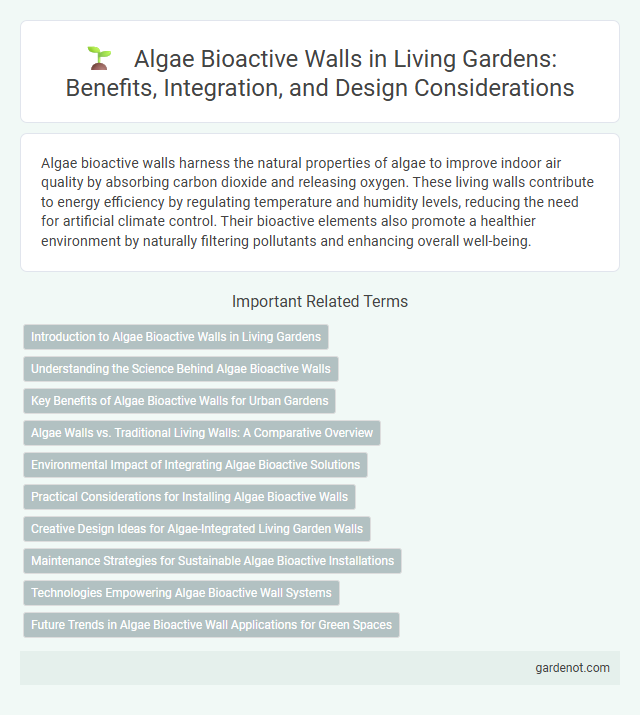Algae bioactive walls harness the natural properties of algae to improve indoor air quality by absorbing carbon dioxide and releasing oxygen. These living walls contribute to energy efficiency by regulating temperature and humidity levels, reducing the need for artificial climate control. Their bioactive elements also promote a healthier environment by naturally filtering pollutants and enhancing overall well-being.
Introduction to Algae Bioactive Walls in Living Gardens
Algae bioactive walls integrate living algae cultures into vertical garden structures, enhancing air purification and oxygen production while reducing carbon dioxide levels. These walls support sustainable urban environments by filtering pollutants and providing natural humidity control, promoting healthier indoor and outdoor spaces. The bioactive properties of algae contribute to biodiversity, making algae walls a functional and eco-friendly addition to modern living gardens.
Understanding the Science Behind Algae Bioactive Walls
Algae bioactive walls harness photosynthetic microalgae to convert carbon dioxide into oxygen, promoting cleaner indoor air quality and reducing urban heat. These living walls utilize chlorophyll-rich algae cells embedded in transparent panels that facilitate light absorption and gas exchange, optimizing biofiltration and energy efficiency. Advanced biotechnological processes control algae growth, ensuring sustained bioactive functionality while minimizing maintenance and water consumption.
Key Benefits of Algae Bioactive Walls for Urban Gardens
Algae bioactive walls enhance urban gardens by improving air quality through natural carbon dioxide absorption and oxygen production, promoting healthier environments. Their ability to regulate humidity and reduce ambient temperatures supports plant growth and increases biodiversity in confined urban spaces. These walls also offer sustainable energy savings by providing natural insulation, reducing reliance on artificial climate control systems.
Algae Walls vs. Traditional Living Walls: A Comparative Overview
Algae bioactive walls offer superior air purification and carbon capture compared to traditional living walls, utilizing photosynthetic microalgae that efficiently convert CO2 into oxygen and biomass. These systems require less maintenance and water, making them more sustainable and cost-effective for urban environments. Algae walls also provide unique bioactive compounds with antimicrobial properties, enhancing indoor air quality beyond the capabilities of conventional plant-based walls.
Environmental Impact of Integrating Algae Bioactive Solutions
Integrating algae bioactive walls significantly reduces carbon dioxide levels by enhancing photosynthetic activity, contributing to improved urban air quality and mitigating greenhouse gas emissions. These walls also promote biodiversity by providing habitat for microorganisms, while their natural filtration properties help reduce airborne pollutants and volatile organic compounds (VOCs). Furthermore, algae bioactive solutions improve energy efficiency in buildings by regulating temperature and humidity, lowering the need for artificial climate control.
Practical Considerations for Installing Algae Bioactive Walls
Installing algae bioactive walls requires careful assessment of light exposure to ensure optimal photosynthesis and bioactivity. Proper water circulation and nutrient delivery systems must be integrated to maintain algae health and prevent stagnation or contamination. Structural support and access for maintenance should be planned to accommodate growth and ease of cleaning without disrupting the bioactive environment.
Creative Design Ideas for Algae-Integrated Living Garden Walls
Algae bioactive walls transform living garden spaces by integrating photosynthetic organisms that enhance air purification and oxygen production. Creative design ideas include modular panels with dynamic lighting to stimulate algae growth and multifunctional surfaces that combine aesthetic appeal with eco-friendly benefits. Incorporating transparent or translucent materials allows natural light to penetrate, supporting algae vitality while creating visually striking green installations.
Maintenance Strategies for Sustainable Algae Bioactive Installations
Effective maintenance strategies for sustainable algae bioactive walls include regular monitoring of light intensity, nutrient supply, and water quality to optimize algae growth and bioactive compound production. Implementing automated irrigation and controlled environmental systems reduces manual intervention and ensures consistent conditions, prolonging the installation's lifespan. Periodic cleaning and algae harvesting prevent biofilm buildup and maintain the wall's aesthetic and functional performance.
Technologies Empowering Algae Bioactive Wall Systems
Algae bioactive wall systems utilize advanced photobioreactor technologies and LED lighting to optimize photosynthesis and maximize biomass production. Innovative nutrient delivery mechanisms and CO2 enrichment enhance algae growth rates, ensuring continuous bioactive compound synthesis. Integration of IoT sensors and automated control systems enables real-time monitoring and adaptive environment regulation, significantly boosting the efficiency and sustainability of living algae walls.
Future Trends in Algae Bioactive Wall Applications for Green Spaces
Algae bioactive walls are emerging as a sustainable solution for urban green spaces, offering enhanced air purification and carbon capture capabilities. Future trends indicate integration with smart monitoring systems to optimize algae growth and bioactive compound production, boosting environmental and health benefits. Advances in genetic engineering promise customized algae strains tailored for specific pollutants and climate conditions, further revolutionizing green architecture.
Algae bioactive wall Infographic

 gardenot.com
gardenot.com